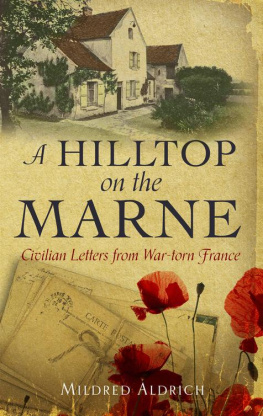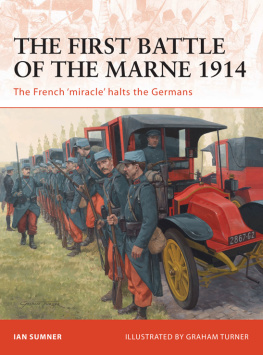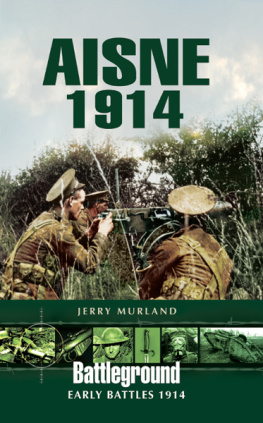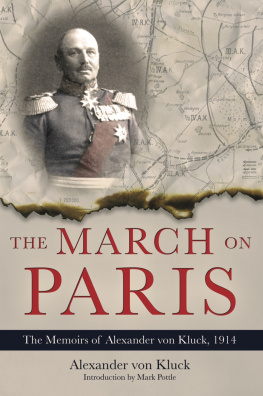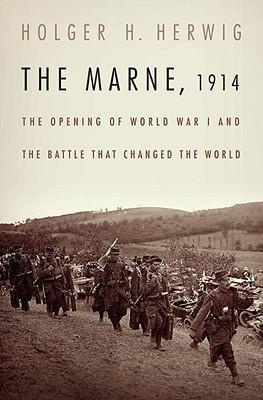
This edition is published by PICKLE PARTNERS PUBLISHING www.picklepartnerspublishing.com
To join our mailing list for new titles or for issues with our books
Or on Facebook
Text originally published in 1920 under the same title.
Pickle Partners Publishing 2013, all rights reserved. No part of this publication may be reproduced, stored in a retrieval system or transmitted by any means, electrical, mechanical or otherwise without the written permission of the copyright holder.
Publishers Note
Although in most cases we have retained the Authors original spelling and grammar to authentically reproduce the work of the Author and the original intent of such material, some additional notes and clarifications have been added for the modern readers benefit.
We have also made every effort to include all maps and illustrations of the original edition the limitations of formatting do not allow of including larger maps, we will upload as many of these maps as possible.
THE
MARCH ON PARIS
AND THE
BATTLE OF THE MARNE
1914
BY
ALEXANDER VON KLUCK
GENERALOBERST
WITH PORTRAIT AND MAPS
AND
NOTES BY THE HISTORICAL SECTION (MILITARY BRANCH) OF THE COMMITTEE OF IMPERIAL DEFENCE
TABLE OF CONTENTS
Contents
TABLE OF CONTENTS 2
AUTHOR'S PREFACE
THE following review of events was completed on the 6th February, 1918. The books which have since been published on the period dealt with, such as Major Bircher's valuable contribution on the Battle of the Marne, that of Field-Marshal French (which appeared in the summer of 1919), and General Maurice's Forty Days in 1914, have not been taken into account. The temptation to enter into the controversies raised by General Baumgarten-Crusius's work has been avoided, although it undoubtedly contains facts of great importance; so also with the books of Field-Marshal von Blow and General von Hausen. Only opinions formed at the time are recorded; those arrived at later have been omitted.
These limitations seem most necessary in order that the appreciation of the situation as it appeared to the headquarters of the First Army in 1914 may be recorded, unaffected by other influences. With this in view, the more important orders and documents have been reproduced verbatim in the text.
The point of view of the Army Commander as regards the dangers of a crossing of the Marne at the beginning of September, 1914, is set forth in the third part of this review. Major-General v. Nordenswan, a Swede, has made many apposite remarks in his book Strategisches aus dem Weltkriege, and has developed them as much as the information at his disposal allowed.
The mutual relations between the headquarters of the First and Second Armies were as helpful as possible. Where opinions differed each stood by its own, and it is for future historians to inquire which party had the greater reason on its side. The general situation after the necessary regrouping of the German Western Army seemed by no means unfavourable, inasmuch as the political and strategic objectives of the war became limited to taking the greatest possible advantage of the strategic weakness of the enemy. To discover where this lies is the principal duty of the supreme command in war.
VON KLUCK.
Generaloberst.
BERLIN,
February, 1920.
LIST OF ILLUSTRATIONS
GENERAL VON KLUCK
MAP OF THE BATTLE OF MONS, 23RD AND 24TH AUGUST,
MAP OF THE BATTLE OF SOLESMESLE CATEAU
BIBLIOGRAPHY
Secret and other papers of the First Army Commander from 9th August to 15th September, 1914.
Memorandum by the Chief of the General Staff of the First Army of the operations during the same period, dated 29th May, 1915.
Despatches of Sir John French of 1914.
Die Schlachten an der Marne vom 6 bis 12 September, 1914. Mittle und Sohn, 1916. Author anonymous.
Hermann Stegemann. Der Krieg. First volume, 1917.
Colonel K. Egli. Zwei Jahre Weltkrieg. August, 1914, to August 1916.
Daily notes of the First Army Commander.
Die Marneschlacht. Professor Dr. Walter Kolbe. Rostock, 1917.
Strategisches aus dem Weltkrieg. V. Nordenswan, Major-General in the Swedish Army.
Stegemann's Weltkrieg und die Marneschlacht. Karl Bleibtreu.
Der Feldzug, 1914. Die Marneschlacht. Original in French by Major Gedel. 1916.
La Victoire de la Marne. Louis Madelin, in the Revue des deux mondes. September, 1916.
L'illustration of 11th September, 1915.
Je sais tout. Magasin de l'activit et de l'nergie nationales. 15th September, 1917.
NOTE ON VON KLUCK'S MILITARY CAREER
ALEXANDER VON KLUCK was born on 20th May, 1846, at Mnster in Westphalia, and was therefore two months younger than his rival, von Blow. His father was a Government architect. He joined the 55th Infantry Regiment on 13th October, 1865, and a few months later took part in the Main Campaign of the war of 1866 as Fhnrich (probationary officer). He was promoted Second Lieutenant on 16th August, 1866. In this rank he served in the Franco-German War, and was wounded in the arm and body at the Battle of Colombey-Nouilly on the east side of Metz on 14th August, 1870, receiving the Iron Cross, 2nd Class. He was promoted Lieutenant in October, 1873, and married Baroness Fanny von Donop a year later. He became Captain in 1878, Major in 1887, Lieutenant-Colonel in 1893, commanding in the last rank an Infantry N.C.O. School for some time. In 1896 he was ennobled by the Kaiser, and given command of Landwehr District No. 1 Berlin. He was promoted Colonel in 1896, given command of the 24th Fusilier Regiment, and shortly afterwards promoted Major-General and made Commander of the 23rd Infantry Brigade. His next step to Lieutenant-General and Commander of the 37th Division came in April, 1902. He remained in this position four years, when he was advanced to General and the command of the V. Army Corps. On 1st October, 1913, he was made an Army Inspector, and on 27th January, 1914, promoted to the rank of Generaloberst.
It will be observed that, unlike von Blow, he had no Staff service, and practically his whole career was spent with troops. On outbreak of war he was appointed Commander of the First Army. Early in 1915 he was, after being wounded, it is believed, relieved of his command and not re-employed in the field.
THE MARCH ON PARIS
INTRODUCTORY
THE following reflections are based on the daily notes of the Army Commander, the official documents, and other sources mentioned in the Bibliography. Their object, so far as the provisional state of historical investigation permits, is to explain and supplement the books and pamphlets already published. Of these, the first volume of Stegemann's history frequently unveils the secret motives of the higher command with striking perspicacity, and skilfully brings out the strategic coherence of the operations.
They are founded on a Memorandum by the commander of the First Army, the original of which was drafted by the Chief of the Staff. It was written during the position warfare on the Aisne in the winter months of 1914-1915, whilst the main events were still vivid in the memories of all those who had taken part in them. This Memorandum was completed and circulated to certain of the higher leaders for their comments, so that any doubts or contradictory reports as to the work and leading of the First Army might be finally disposed of, and the great achievements of all its corps, its cavalry corps, and their commanders placed definitively in their true light.




